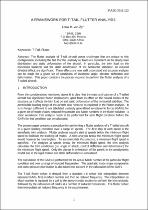JavaScript is disabled for your browser. Some features of this site may not work without it.
- ResearchSpace
- →
- Research Publications/Outputs
- →
- Conference Publications
- →
- View Item
| dc.contributor.author |
Van Zyl, Louwrens H

|
|
| dc.date.accessioned | 2011-08-10T13:55:46Z | |
| dc.date.available | 2011-08-10T13:55:46Z | |
| dc.date.issued | 2011-06 | |
| dc.identifier.citation | Van Zyl, L.H. 2011. Framework for T-tail flutter analysis. International Forum on Aeroelasticity and Structural Dynamics 2011 (IFASD2011), Paris, France, 26-30 June 2011, pp. 14 | en_US |
| dc.identifier.uri | http://hdl.handle.net/10204/5123 | |
| dc.description | International Forum on Aeroelasticity and Structural Dynamics 2011 (IFASD2011), Paris, France, 26-30 June 2011 | en_US |
| dc.description.abstract | The flutter analysis of T-tail aircraft poses challenges that are unique to this configuration, including the fact that the unsteady air loads are dependent on the steady load distribution and static deformation of the aircraft. In particular, the trim load on the horizontal stabilizer and the static deformation of the horizontal stabilizer, an induced dihedral effect, are significant. These effects are now well understood and accurate analyses can be made for a given set of conditions of incidence angle, elevator deflection and deformation. This paper considers the process required to perform the flutter analyses of a T-tailed aircraft. | en_US |
| dc.language.iso | en | en_US |
| dc.relation.ispartofseries | Workflow;6759 | |
| dc.subject | T-tail | en_US |
| dc.subject | Flutter | en_US |
| dc.title | Framework for T-tail flutter analysis | en_US |
| dc.type | Conference Presentation | en_US |
| dc.identifier.apacitation | Van Zyl, L. H. (2011). Framework for T-tail flutter analysis. http://hdl.handle.net/10204/5123 | en_ZA |
| dc.identifier.chicagocitation | Van Zyl, Louwrens H. "Framework for T-tail flutter analysis." (2011): http://hdl.handle.net/10204/5123 | en_ZA |
| dc.identifier.vancouvercitation | Van Zyl LH, Framework for T-tail flutter analysis; 2011. http://hdl.handle.net/10204/5123 . | en_ZA |
| dc.identifier.ris | TY - Conference Presentation AU - Van Zyl, Louwrens H AB - The flutter analysis of T-tail aircraft poses challenges that are unique to this configuration, including the fact that the unsteady air loads are dependent on the steady load distribution and static deformation of the aircraft. In particular, the trim load on the horizontal stabilizer and the static deformation of the horizontal stabilizer, an induced dihedral effect, are significant. These effects are now well understood and accurate analyses can be made for a given set of conditions of incidence angle, elevator deflection and deformation. This paper considers the process required to perform the flutter analyses of a T-tailed aircraft. DA - 2011-06 DB - ResearchSpace DP - CSIR KW - T-tail KW - Flutter LK - https://researchspace.csir.co.za PY - 2011 T1 - Framework for T-tail flutter analysis TI - Framework for T-tail flutter analysis UR - http://hdl.handle.net/10204/5123 ER - | en_ZA |






